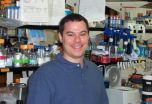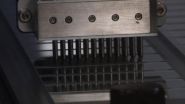(Press-News.org) CHAPEL HILL, N.C. – The function of histones -- the proteins that enable yards of DNA to be crammed into a single cell -- depends on a number of chemical tags adorning their exterior. This sophisticated chemical syntax for packaging DNA into tight little coils or unraveling it again -- called the "histone code" -- is the latest frontier for researchers bent on understanding how genetics encodes life.
But recent research from the University of North Carolina at Chapel Hill has found a number of issues with histone antibodies, the main tools used to decipher this code, suggesting they may need more rigorous testing.
"When I have presented our findings at major meetings, the reactions of my peers have been shock and awe across the board," said senior study author Brian Strahl, PhD, associate professor of biochemistry and biophysics at UNC.
"Hundreds and hundreds of researchers around the world use them and assume they are accurate. Yet we have found that they need to be used with caution." Strahl is a member of the UNC Lineberger Comprehensive Cancer Center.
The results of the study, which appears online December 16, 2010, in the journal Current Biology, also found that the proteins that interpret the histone instructions are affected not just by the specific chemical tag they land on but also by other tags in the neighborhood.
The "Histone Code" was first proposed almost ten years ago by Strahl and epigenetics researcher C. David Allis, who was his postdoctoral advisor at the time. In a review article published in the journal Nature that has since been cited over 3000 times, Strahl and Allis suggested a model of how histones and their posttranslational modifications may function in chromatin.
Histones are the protein spools around which strands of DNA are wrapped to form a package called chromatin. Depending on the modifications or tags decorating the histones, DNA is either closed up tightly within this package or lies open so that its genes can be read.
Strahl and Allis hypothesized that distinct combinations of histone modifications work together to form a code, akin to the classic genetic code in which distinct combinations of nucleotides make an amino acid. These histone modifications – chemical changes like phosphorylation, acetylation and methylation -- generate a language that is interpreted through the ability to recruit the proteins that modulate chromatin.
"But this histone code is way more complicated, because there are over a 100 different histone modifications, and they are working in a three-dimensional space that is very difficult to visualize," said Strahl. "We can't say that this mark or this combination of modifications will always mean a certain thing. But what I think we can say is that multiple modifications can help tip the balance of one chromatin state to another, making the underlying DNA more or less accessible to the protein machinery."
In order to uncover what some of those codes might be, the researchers started generating chunks of histone proteins, each engineered to contain various combinations of modifications. In a completely new approach to the histone code, Strahl and his colleagues printed these modified chunks or peptides onto glass slides, generating peptide arrays akin to DNA arrays.
When they tested widely used commercial antibodies that were directed against specific modifications on histones, like methylysine or methylarginine, they found the antibodies didn't always recognize the site they were supposed to, sometimes even binding to off-targets better than their intended target.
The results fit nicely with a study published recently in Nature Structural Biology by Jason Lieb, Ph.D., a professor of biology at UNC and a Lineberger Center member. Lieb used older approaches like immunofluorescence, CHIP and Western blots to show that many commercial antibodies were not performing as they should.
An additional finding of the study by Strahl and colleagues was that antibodies, as well as the proteins that naturally bind chromatin, were greatly affected by neighboring modifications.
"This result gives further support to the idea of the histone code, in
that the ability of a protein to bind to histones may depend on a
particular modification landscape and not just one single modification"
said Strahl. "The presence of an acetylation site nearby could impact
the binding of a protein at its intended phosphorylation site. So
altogether these modifications generate a landscape that is vitally
important in how proteins read the histone code."
INFORMATION:
The research was funded by the National Institutes of Health. Study
co‑authors were Stephen Fuchs, Ph.D., a postdoctoral scientist in
Strahl's lab, and Krzysztof Krajewski , a research assistant professor
at UNC.
Tools used to decipher 'histone code' may be faulty
2010-12-17
ELSE PRESS RELEASES FROM THIS DATE:
A 'spin ratchet': A new electronic structure for generating spin current
2010-12-17
A research team from the Institut Català de Nanotecnologia (ICN), in Barcelona, has demonstrated a device that induces electron spin motion without net electric currents, a key step in developing the spin computers of the future. The results are published in the Dec 17 issue of the journal Science. The authors are Marius V. Costache and Sergio O. Valenzuela, an ICREA Professor who is leader of the Physics and Engineering of Nanodevices Group at ICN.
Spintronics is a branch of electronics that aims to use the electron spin rather than its charge to transport and store ...
Better spaces for older people
2010-12-17
The research project 'Older People's Use of Unfamiliar Space' (OPUS) examined the strategies used by older people to find their way in unfamiliar spaces as pedestrians and users of public transport. As part of the research, older people were shown town scenes and pedestrian routes and gave feedback on signposting, ease of navigation and general impressions. Their heart rates were measured to monitor stress levels. Participants were also taken to a town centre to walk through the same routes in person.
Initial findings show:
Signs are of limited use even in unfamiliar ...
Genome code cracked for most common form of pediatric brain cancer
2010-12-17
Scientists at the Johns Hopkins Kimmel Cancer Center have deciphered the genetic code for medulloblastoma, the most common pediatric brain cancer and a leading killer of children with cancer. The genetic "map" is believed to be the first reported of a pediatric cancer genome and is published online in the December 16 issue of Science Express.
Notably, the findings show that children with medulloblastoma have five- to tenfold fewer cancer-linked alterations in their genomes compared with their adult counterparts, the scientists say.
"These analyses clearly show that ...
CHOP experts collaborate in gene survey of childhood brain cancer; intriguing clues found
2010-12-17
Pediatric cancer researchers at The Children's Hospital of Philadelphia contributed important expertise to a new landmark study of medulloblastoma, a type of brain tumor typically found in children. The large multicenter study defines the genetic landscape of this cancer, and holds intriguing clues to gene changes on signaling pathways that may become fruitful targets for future therapies.
The most common cancerous brain tumor in children, medulloblastoma is, fortunately, rare. However, it causes significant mortality, and survivors may suffer serious long-term side effects ...
Iowa State, Ames Lab physicist developing, improving designer optical materials
2010-12-17
AMES, Iowa – Advancements in fabrication technologies may lead to superlenses and other designer optical materials, according to an Iowa State University and Ames Laboratory physicist.
In an article titled "Improving Metamaterials" published in the Perspectives section of the Dec. 17 issue of the journal Science, Costas Soukoulis and Martin Wegener write about the man-made materials designed to deliver certain properties not found in nature.
Soukoulis is an Iowa State University Distinguished Professor and Frances M. Craig Professor of Physics and Astronomy and a senior ...
Liver cancer in cirrhotic patients effectively treated with radiofrequency ablation
2010-12-17
Researchers from Italy determined that radiofrequency ablation (RFA) is a safe and effective therapy for managing hepatocellular carcinoma (HCC) in cirrhotic patients. The high repeatability of RFA is advantageous in controlling recurrences of cancerous tumors in the liver. Results of this 10-year retrospective study are available in the January 2011 issue of Hepatology, a journal published by Wiley-Blackwell on behalf of the American Association for the Study of Liver Diseases (AASLD).
HCC is the third leading cause of death from cancer worldwide and according to the ...
Scientists discover powerful biomarker panel for the early detection of breast cancer
2010-12-17
In the war on cancer, perhaps there is nothing more powerful in a physician's arsenal than early detection. Despite recent advances in early detection and treatment, breast cancer remains a common and significant health problem in the United States and worldwide. Approximately one in ten women will get breast cancer in their lifetime and more than half of women with late stage cancer (II and III) have no cure or effective therapeutic available.
Using a new, powerful method for rapidly screening molecules associated with disease, proteomics expert Joshua LaBaer and colleagues ...
Study shows garlic could protect against hip osteoarthritis
2010-12-17
Researchers at King's College London and the University of East Anglia have discovered that women who consume a diet high in allium vegetables, such as garlic, onions and leeks, have lower levels of hip osteoarthritis.
The findings, published in the BMC Musculoskeletal Disorders journal, not only highlight the possible effects of diet in protecting against osteoarthritis, but also show the potential for using compounds found in garlic to develop treatments for the condition.
A relationship between body weight and osteoarthritis was previously recognised, although it ...
Lost images of 'human exhibits' in Britain discovered
2010-12-17
A University of Leicester researcher has discovered two photographic images, presumed lost, of native Americans brought to Britain by Roger Casement a century ago.
Dr Lesley Wylie, Lecturer in Latin American Studies in the School of Modern Languages, University of Leicester, made the discovery during her research for a book on the Putumayo, a border region in the Amazon. Her book forms part of the AHRC-funded research project, American Tropics: Towards A Literary Geography, based at the University of Essex.
The photographs were found among a photographic collection ...
Alcoholics beware -- genetic variation linked to liver cirrhosis in Caucasians
2010-12-17
A new study by German researchers found that a variation in the PNPLA3 (adiponutrin) gene was associated with cirrhosis of the liver and elevated transaminase (liver enzyme) levels in alcoholic Caucasians. The risk of cirrhosis in alcoholics in the genetic high risk group might be as high as 25% to 50%. Full findings are published in the January 2011 issue of Hepatology, a journal of the American Association for the Study of Liver Diseases.
Alcoholic liver disease (ALD)—ranging from alcoholic fatty liver to alcohol induced liver fibrosis and cirrhosis—accounts for more ...



